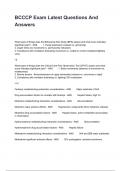BCCCP Exam Latest Questions And
Answers
What types of things does the Behavioral Pain Scale (BPS) assess and what score indicates
significant pain? - ANS 1. Facial expression (relaxed vs. grimacing)
2. Upper limbs (no movement vs. permanently retracted)
3. Compliance with ventilation (tolerating movement vs. unable to control ventilation/fighting
vent)
>5
What types of things does the Critical-Care Pain Observation Tool (CPOT) assess and what
score indicates significant pain? - ANS 1. Body movements (absence of movement vs.
restlessness)
2. Muscle tension - flexion/extension of upper extremities (relaxed vs. very tense or rigid)
3. Compliance with ventilator (tolerating vs. fighting) OR vocalization
>=3
Fentanyl metabolic/drug interaction considerations - ANS Major substrate of 3A4
Drug accumulation factors to consider with fentanyl - ANS Hepatic failure, high Vd
Morphine metabolic/drug interaction considerations - ANS Glucuronidation
Morphine major adverse effects - ANS Hypotension, bradycardia (from histamine release)
Morphine drug accumulation factors - ANS Hepatic failure, active metabolite accumulates
in renal failure
Hydromorphone metabolic/drug interaction considerations - ANS Glucuronidation
Hydromorphone drug accumulation factors - ANS Hepatic failure
Methadone metabolic/drug interaction considerations - ANS 3A4 and 2B6 major substrates
Methadone significant adverse effects - ANS QTc prolongation, serotonin syndrome
,Methadone drug accumulation factors - ANS Long half-life, hepatic and renal failure will
delay clearance
Remifentanyl clearance - ANS blood and tissue esterase (not dependent on organ
function)
Which IV opioids will not cause bradycardia - ANS Hydromorphone, methadone
Which IV opioid will not cause hypotension - ANS methadone
Which IV opioids carry a risk of serotonin syndrome with other serotinergic agents - ANS
fentanyl, morphine, methadone
Which IV opioids can accumulate with liver failure - ANS fentanyl, morphine,
hydromorphone, methadone
Which IV opioids can accumulate with renal failure - ANS morphine, methadone
How is propofol cleared - ANS Hepatic (caution in patients with hepatic impairment or
cirrhosis)
How many calories and grams of fat does propofol have - ANS 1.1 kcal/mL or 0.1 g/mL
What are some clinical characteristics of PRIS - ANS metabolic acidosis, acute renal
failure, cardiovascular collapse, cardiac arrhythmias, rhabdo, myoglobinuria, hyperkalemia,
hyperTG, elevated CK
Which sedative may have weak opiate-sparing antinociceptive effects - ANS Precedex
Recommended duration of Precedex - ANS Package insert recommends therapy for 24
hours or less, RCTs have used it up to 5-7 days, and safety beyond 7 days is not well
established
Lorazepam vs. midazolam clearance and volume of distribution - ANS Lorazepam: hepatic
clearance by conjugation to inactive compounds, moderate to high Vd
Midazolam: hepatic clearance by glucuronidation to an active metabolite which is renally
cleared, large Vd
What to do with sedation and analgesia during an SAT - ANS Hold continuous sedative
and analgesic infusions and bolus opioids for breakthrough pain (continuous opioid infusions
allowed to continue while stopping sedatives if presence of active pain)
What to do with sedation and analgesia if SAT fails - ANS Bolus opioids before restarting
infusion. Re initiate sedative infusion, if necessary, at half the previous dose and titrate to goal
,If a patient is delirious, which classes of medications should be scrutinized for need and
appropriate dosage? - ANS 1. Anticholinergics
2. BZDs
3. Opiates
4. Antipsychotics
5. Antispasmodics
6. Anticonvulsants
7. Corticosteroids
What are precipitants of delirium to keep in mind and try to treat - ANS 1. Infection
2. Dehydration or malnutrition
3. Sleep deprivation
4. Centrally acting medications (benzodiazepines, opiates, anticholinergics)
5. Lack of exposure to sunlight
6. Lack of personal interaction
7. Physical restraints or insertion of catheters or tubes
Out of the following antipsychotics for delirium (haloperidol, olanzapine, quetiapine, risperidone,
ziprasidone), which:
1. Have the least anticholinergic effects?
2. Are the most sedating?
3. Have the highest risk of EPS?
4. Have the highest risk of NMS?
5. Have a risk of neuromuscular weakness?
6. Have a risk of orthostatic hypotension?
7. Have a risk of cardiac conduction abnormalities? - ANS 1. Haloperidol, risperidone,
ziprasidone
2. Olanzapine, quetiapine
3. Haloperidol, risperidone
4. All have a low risk of NMS
5. Olanzapine
6. Quetiapine and risperidone
7. Risperidone
When may a short term (<48 hours) NMBA be beneficial? - ANS Severe ARDS
(PaO2/FiO2 < 120 mmHg)
2 classes of NMBA, MOA, and examples - ANS 1. Depolarizing: binds and activates
acetylcholine receptors causing persistent depolarization (succinylcholine)
2. Nondepolarizing: blocks the action of acetylcholine and the neuromuscular junction (all others
- vec, roc, atra, cisatra)
Succinylcholine duration - ANS 4-6 min
, Vecuronium:
1. Metabolism
2. Duration - ANS 1. Hepatically metabolized and some renal clearance with an active
metabolite
2. Duration 30 min
Rocuronium
1. Metabolism
2. Duration - ANS 1. Hepatically metabolized
2. 30-40 min
Atracurium
1. Metabolism
2. Duration
3. Unique adverse effects - ANS 1. Hofmann elimination to form the toxic metabolite
laudanosine which is then hepatically and renally cleared (may precipate seizure activity)
2. 30-40 min
3. Histamine release may cause cardiovascular adverse effects and bronchospasm
Cisatracurium
1. Differences from atracurium
2. Metabolism
3. Duration - ANS 1. slower onset, no histamine release, produces laudanosine and much
lower levels
2. Hofmann elimination
3. 30-60 min
RIsk factors for stress-related bleeding - ANS 1. Respiratory failure requiring mechanical
ventilation for 48 hours or longer OR
2. Coagulopathy: PLT<50, INR>1.5, aPTT >2x control
Variables associated with the risk of GIB while receiving prophylaxis - ANS Renal
failure/AKI/RRT, age 50 or older, acute respiratory failure, MI, neurologic injury, sepsis, shock,
acute or chronic hepatic failure, coagulopathy
What are other risk factors for stress-related mucosal disease besides the two independent risk
factors? - ANS 1. Spinal cord/head trauma
2. Thermal injury affecting more than 35% of total body surface area
3. History of GIB within the past year
4. Postoperative transplant
5. Ulcerogenic medications (NSAIDs, CS)




